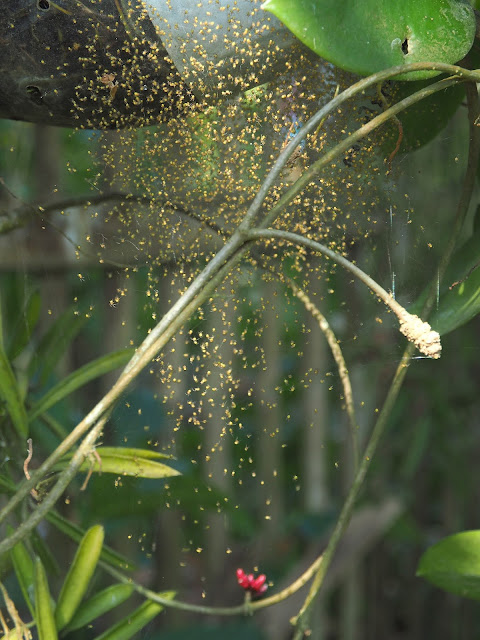Our rainy season this year officially started first week of June. It is a much awaited moment to alleviate our extreme heat and discomfort brought by the long dry season, an El Niño year. The effect for humans is not sudden, but a pacifier, as it is still very hot when we go out from 10:00am to 3:00pm. However, the almost daily thunderstorms in the afternoons bring rains to many places. Thunder and lightning are welcome if they will bring in the rains!
The plants are all rejoicing! The first heavy rains immediately produced the transformed look. Dormant bulbs and seeds emerged on cue. Drying branches immediately produced shoots, and in one week growth is already very prominent among all plants. Grasses, nonetheless, are the most responsive and quick. The roadsides suddenly get carpets of green, giving us panacea to bored minds reminiscent of dull surroundings. My soul suddenly engaged again to a new vibrant surroundings. Our garden in the province has been teeming with growths, scents, and lovely blooms. Hmmm, i was not able to go home last weekend, but i am sure lots of them are still there this weekend, waiting for me appreciate them more.
A week after the first heavy rains, the air around our property is very well scented in the mornings. It is courtesy of the few coffee plants surviving on their own.
The 2 photos above and the pompoms closed-up below is the
'Liberica' variety, made famous as
"Kapeng Barako" in Batangas. The berries are the biggest among the coffee varieties of commerce. Since kids we are already familiar with drinking coffee, mostly from this "Kapeng Barako".
The above coffee flowers are also sweetly scented, but is the 'Robusta' variety. Its berries are small and most famous in the nearby province of Cavite. It is used with other varieties to make lovely coffee blends, together with 'Éxcelsa' and 'Arabica' varieties. This last one is very aromatic as ground beans, but grow only in colder highlands.
Above is the response of the dormant bulbs of Hippeastrum puniceum to rain. Notice that other grasses around the mounds are not yet growing, but the scapes and some leaves are already showing luxurious growths.
This is the growth of the H. puniceum in the same area 3 weeks after the first heavy rains. A lot more of the hedges are at the right side of the area, but my niece did not take the photos. She just sent it to me by FB.
close-up of the Hipeastrum puniceum
Hippeastrum roseum planted in a pot. The bloom is a bit smaller than H puniceum, but the stripes on the petals make it so lovely. By the way, i read somewhere that its more correct name is Rhodophiala rosea.
Hippeastrum johnsonii blooms ahead of the H puniceum. It actually emerged immediately a week after the first heavy rains.
They made the area more lively and conspicuous. I wish there still are some followers when these dehisced. I hope to take more of their photos.
even the back is so attractive for me
This crinum is newly planted, the friend who gave it to me said it becomes a very big plant. It hasn't acclimatized very well yet to the sun, so still under some potted plants, but it already produced that scape to become white scented blooms. Unfortunately, i didn't see the blooms.
You can still see the very dry grounds despite the first heavy rains. Grasses are not emerging yet, but this endemic Proiphys amboinensis already sent scape and leaves. Its umbel of white flowers is also scented and very beautiful. However, it only blooms once a year during this condition. The rest of the year will only be showing the maturing leaves, somehow looking like green hostas.
this succulent, sedum, was already blooming during the dry season, but becomes lovelier with more flowers after the first rains.
Of course, i will not end my post without the hoyas. They also responded so well with the rains, the leaves got washed, environment gets colder and humidity increased. They love it.
bloom of the above mother plant, Hoya pubicorolla formerly Hoya pubicalyx 'Black Dragon'
Hoya benguetensis plant (above) and close-up of the umbel (below)
Hoya multiflora, they also call this shooting stars hoya
the more common Hoya carnosa, lovely even if they are around for long
Hoya mindorensis
Hoya Viola
Next weekend when i go home, i am sure there are already lots of butterflies. Their larvae will have lots of host plants, which i am sure will now roam around our nectar plants including the hoyas. Butterflies, here i come!









































